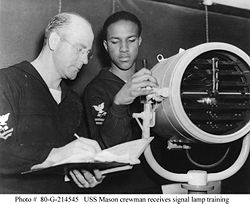- Signal lamp
-
A signal lamp (sometimes called an Aldis lamp, named after Arthur C. W. Aldis who invented a widely used design) is a visual signaling device for optical communication (typically using Morse code). Modern signal lamps are a focused lamp which can produce a pulse of light. This pulse is achieved by opening and closing shutters mounted in front of the lamp, either via a manually-operated pressure switch or, in later versions, automatically. The lamps were usually equipped with some form of optical sight, and were most commonly used on naval vessels and in airport control towers (using color signals for stop or clearance).
Contents
Aldis lamps were pioneered by the British Royal Navy in the late 19th century, and continue to be used through the present day on naval vessels. They provide handy, secure communications during periods of radio silence as well as other times and were particularly useful for convoys operating during the Battle of the Atlantic. There were several types. Some signal lamps were mounted on the mastheads of ships, some small hand-held versions were also used ('The Aldis lamp') and other more powerful ones were mounted on pedestals. These larger ones used a carbon arc lamp as their light source with a diameter of 20 inches (50 cm). These could be used to signal to the horizon, even in conditions of bright sunlight. Although it was originally thought that it was only possible to communicate by line-of-sight, in practice it was possible to illuminate cloud bases both during the night and day which allowed for communication beyond the horizon. A maximum transmission rate possible by using flashing lights is no more than 14 wpm.
They have a secondary function as simple spotlights.
The idea of flashing dots and dashes from a lantern was first put in to practice by Captain, later Vice Admiral, Philip Colomb in 1867. His original code, which the Navy used for seven years, was not identical with Morse, but Morse code was eventually adopted with the addition of several special signals. Flashing lights were the second generation of signaling in the Royal Navy, after the flag signals most famously used to spread Nelson's rallying-cry before the Battle of Trafalgar.
The Commonwealth Navies and NATO forces use signal lamps when radio communications need to be silent or electronic "spoofing" is likely. Also, given the prevalence of night vision equipment in today's armed forces, signaling at night is usually done with lights that operate in the infrared (IR) spectrum making them less likely to be detected. All modern forces have followed suit due to technological advances in digital communications.
Air traffic control usage
Main article: Aviation light signalsIn air traffic control towers, signal lamps are still used today, as a backup device in case of a complete failure of an aircraft's radio. Light signals can be red, green or white, and steady or flashing. Messages are limited to a handful of basic instructions (e.g. "land", "stop" etc.); they are not intended to be used for transmitting messages in Morse code. Aircraft can acknowledge signals by rocking their wings or flashing their landing lights.[1]
See also
References
External links
Transmission methods Electrical telegraph · On-off keying · Continuous wave · Modulated continuous wave · Heliograph · Signal lampNotable signals Other writing systems
in Morse codeCategories:- Early telecommunications
- Lamps
- Military communications
- Morse code
Wikimedia Foundation. 2010.


